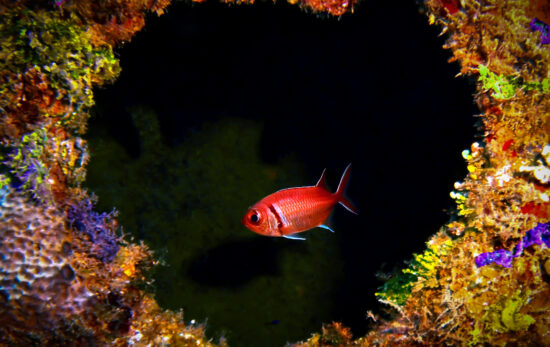Vast blue waters, plummeting wall dives, and pelagic life are just a few reasons why you’ll find some of the world’s best diving in the Caribbean. From the Bahamas in the north to Bonaire in the south, the Caribbean is a serious hotspot among divers looking to travel and Live Unfiltered.
Are you wondering which Caribbean island has the best diving? Well, that depends on what you’re looking for. This tropical paradise has the best shore diving for beginners, deep wreck adventures for technical divers, and is a playground for underwater photographers.
So, whatever your interest, let’s take a look at 15 top locations for the best diving in the Caribbean.

1. Belize
Between Mexico and Guatemala lies Belize. This tiny country is home to the Belize Barrier Reef Reserve System (BBRRS), a UNESCO World Heritage Site as the world’s second-largest reef system. As well as the world-famous 410-foot-deep (125m) Blue Hole, this astounding location holds over 400 islands and is one of the best places for scuba diving in the Caribbean. Above all, the country boasts shore diving, gentle conditions for beginners, and likely whale shark encounters between April and June.
Half Moon Caye is one of the popular sites in Belize. It offers astounding visibility, often at least 65 feet (20m), and exceptional marine flora at Open Water Diver-level depths. Turneffe Atoll (a circular reef system) is a bucket-list destination for larger marine life lovers, with common reef shark and sea turtle sightings.

2. Bonaire
Often dubbed the “Diver’s Paradise”, Bonaire is certainly a shore diver’s dream. It sits in the southern part of the Caribbean Sea, with its topography providing dive sites that belong on any list of the best diving in the Caribbean.
Firstly, for advanced-level dives (requiring an Advanced Open Water Diver certification), the Hilma Hooker wreck rests at 100 feet (30m) between two reef systems. It’s a breathtaking microcosm of diving in Bonaire itself — it has everything!
Furthermore, easily distinguishable by labeled yellow rocks, some of the most exciting shore dives in Bonaire include Angel City, 1000 Steps, and Karpata. 1000 Steps is particularly famous due to the “staircase” taken down into the water, while wreck lovers enjoy Karpata‘s array of ship anchors.

3. Cozumel, Mexico
Cozumel sits on Mexico’s Caribbean coast and is known as a year-round diving destination. It’s easy to get to with some of the best Caribbean diving resorts for all budgets and has over 45 dive sites! The southern area of Cozumel is also protected as a marine park, successfully maintaining circuses of colorful marine life for beginners and advanced-level swim-throughs and drift dives.
As well as smaller life, dives in Cozumel may also involve encounters with nurse sharks, eagle rays, turtles, green moray eels, and the rare splendid toadfish. Alongside the magical underwater world, Cozumel also boasts great nightlife and on-shore activities for non-divers.
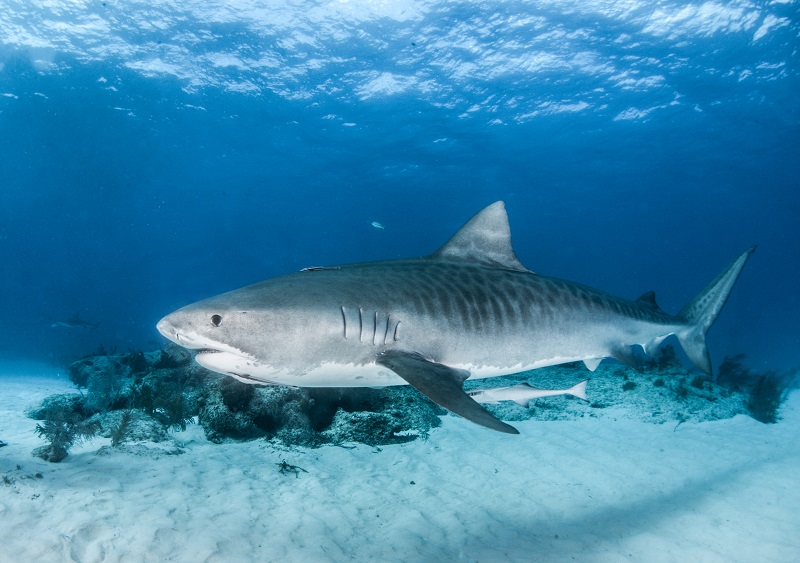
4. The Bahamas
With national parks, island culture, and flamingos, the Bahamas is not only a gold-star dive location but also a fun-filled destination for non-divers, too. The archipelago is located between the Caribbean Sea and the Western Atlantic Ocean, with over 700 islands.
Additionally, adrenaline-seekers will enjoy the aptly named Tiger Beach. That’s to say, it’s a hotspot for tiger sharks, while you can also catch hammerheads at Bimini on the same trip, ensuring some of the best shark diving in the Caribbean.
The hardest part of a trip to the Bahamas is trying to choose which dive sites to visit, as the possibilities are endless. Jeep wrecks in Jeep Reef or advanced drift dives in Eleuthera and Harbour Island – which will you choose first?
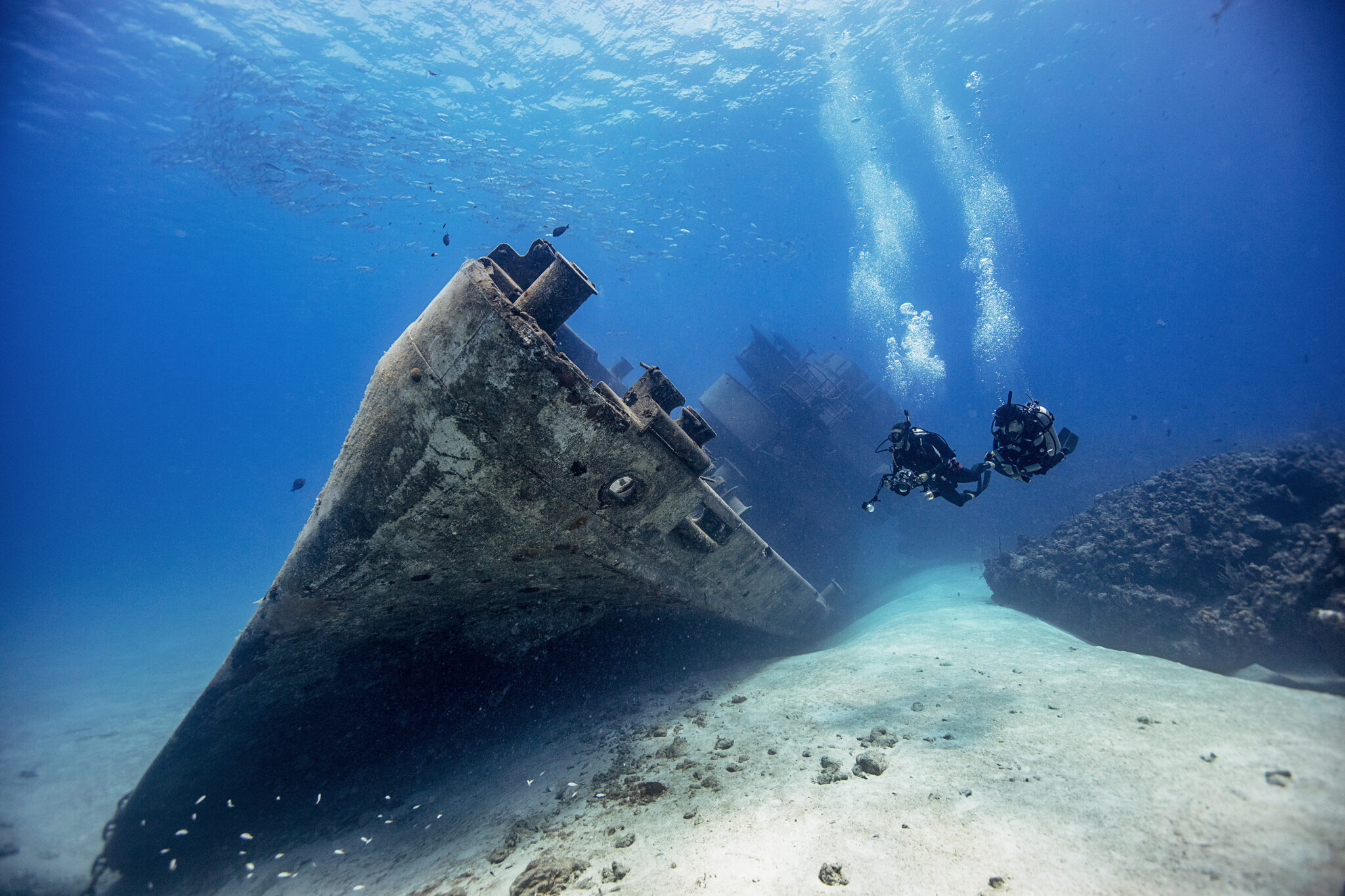
5. Cayman Islands
Grand Cayman possesses one of the best wrecks in the Caribbean, the USS Kittiwake. It rests at around 65 feet (19m) and is accessible for all abilities (the top of the wreck starts at 15ft/4m). The USS Kittiwake was artificially placed here in 2011 after being donated by the United States Maritime Administration (MARAD).
Aside from wrecks, the Caymans also boast Stingray City. This is a collection of sandy banks that house huge arrays of stingrays accessible for both divers and snorkelers. On Little Cayman, you’ll also be able to explore the perplexing Bloody Bay Wall site that most divers dream of visiting. This really is some of the best snorkeling and scuba diving in the Caribbean!

6. Curaçao
Curaçao is a Dutch Caribbean Island stretching 171 square miles (444 square kilometers). Without a doubt, the island is most famous for its extensive marine life and rich coral reefs, making it one of the best diving places in the Caribbean. The lack of strong currents means this island is a gentle yet stunning place to start for beginners. However, Mushroom Forest still gives boat divers their fix.
The Caribbean certainly has a trend of striking wrecks, and the Superior Producer in Curaçao is no exception. The wreck allows divers to enter the cargo holds and wheelhouse, where you’ll encounter lurking schools of barracuda and groupers.

7. Roatán, Honduras
A border of coral reefs encapsulates this lush, mountainous landscape. This is the largest of the three Bay Islands in Honduras and offers some of the best diving in the Caribbean for all levels. Above all, a must-see in Roatán is the famous Hole in the Wall. First, it begins with a vertical descent down the hole before opening up to the endless blue alongside the reef wall. This site even welcomes beginners with swim-throughs and caves at shallow depths.
Then, for bright corals, schools of fish, and the possibility of rays and moray eels, head to Sea Quest Shallow. Unbelievably, Roatán adds the El Aguila wreck to its catalog of dive sites, pairing a three-piece, 210-foot-long (63m) wreck with an adjacent reef.
Roatán is where hardcore divers fall in love with the underwater world all over again. Likewise, beginners wonder why they didn’t start diving sooner.

8. Dominican Republic
There are five highly renowned dive spots in the Dominican Republic: Bayahibe, Airport Wall, Santo Domingo, Juan Dolio, and Paradise Reef. Bayahibe is one of the most loved locations with its vista of caves, wrecks, and deep dives. Beginners can access the 43-foot-deep (13m) Atlantic Princess wreck, while deep-certified divers can venture down to Saint George at 120 feet (36m).
Furthermore, just north of the Dominican Republic is Silver Bank. In short, this sunken bank tucked in the blue sea of the Caribbean is one of the very few locations worldwide to swim with humpback whales. It’s a dedicated breeding and calving zone for this pelagic species between January and April, resulting in some of the best Caribbean diving during the winter months.

9. Turks and Caicos
Just southeast of the Bahamas, you’ll reach Turks and Caicos. The slightly more secluded archipelago is inclusive of 40 islands split in two by the Turks Island Passage — a vast 7,200-foot-deep (2,200m) underwater trench. The most popular of the islands is Providenciales. It holds extraordinarily colorful reef walls as well as nurse shark gatherings between July and September.
Turks and Caicos is particularly bucket-list-worthy, because it’s one of the best Caribbean countries for scuba diving with megafauna. From January to March, the trench serves as an underwater passageway for schools of migrating marine life. Indeed, humpback whales, turtles, and dolphins can all be seen here.
The islands include unbeatable wall dives in the Caribbean with submerged cliffs. Local drop-offs and caverns are populated with nudibranchs and other macro life. In addition, Salt Cay’s HMS Endymion wreck is a must-see wreck in this less tourist-heavy destination.
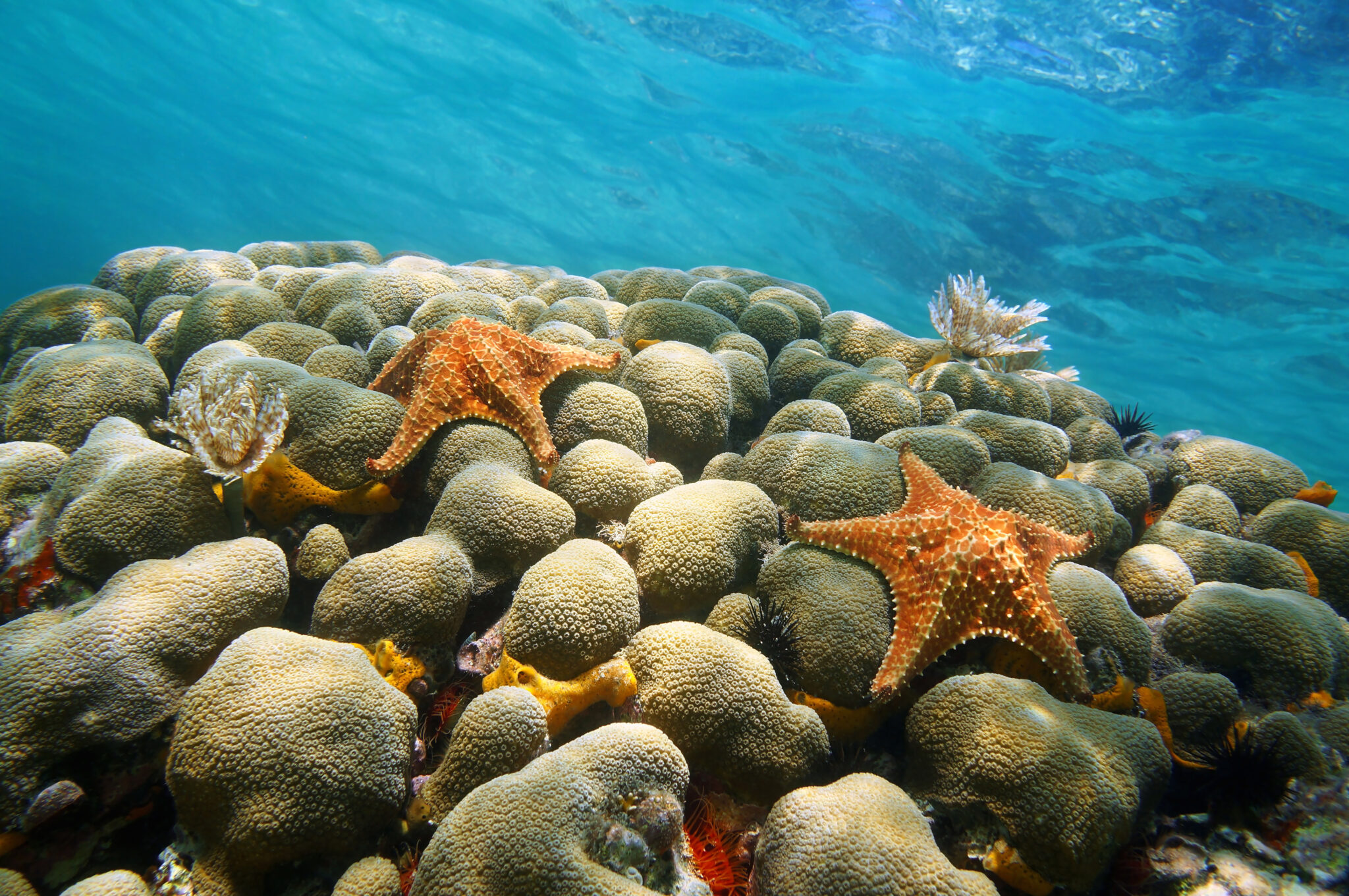
10. Aruba
Just a 10-minute boat ride from the shore, Aruba houses the famous Antilla wreck, making it one of the best Caribbean dive spots. The sunken wreck is split into two parts, resting at 60 feet (18m) deep, with some parts visible above water. Divers can expect to see lobsters, turtles, and moray eels, if they’re lucky!
Additionally, the island currently has 14 reef dive sites, seven wrecks, and seven dedicated drift sites. Aruba is a particularly popular location from April to August, but it is comfortable year-round due to its location outside “Hurricane Alley“. Aruba is much loved among non-divers, too, thanks to pearly white beaches, casinos, and easily accessible snorkeling sites.

11. Grenada
Where is the unofficial capital of the Caribbean for wreck diving? Grenada. Just 100 miles (160km) north of Venezuela, this relaxed island offers a wealth of wreck dives for all levels, but the most impressive is undoubtedly the Bianca C. Sitting between 100 and 165 feet (30-50m), this world-class 600-foot-long (183m) cruise liner is a must for deep and technical divers.
Action-packed drifts also await divers at Fisherman’s Paradise, where the Caribbean Sea meets the Atlantic Ocean. This is also a nutrient-rich home for octopuses, eagle rays, moray eels, and nurse sharks.
Meanwhile, closer to shore and accessible even by snorkelers and glass-bottom boats, the acclaimed Molinere Underwater Sculpture Park is a work of living art and shouldn’t be missed.
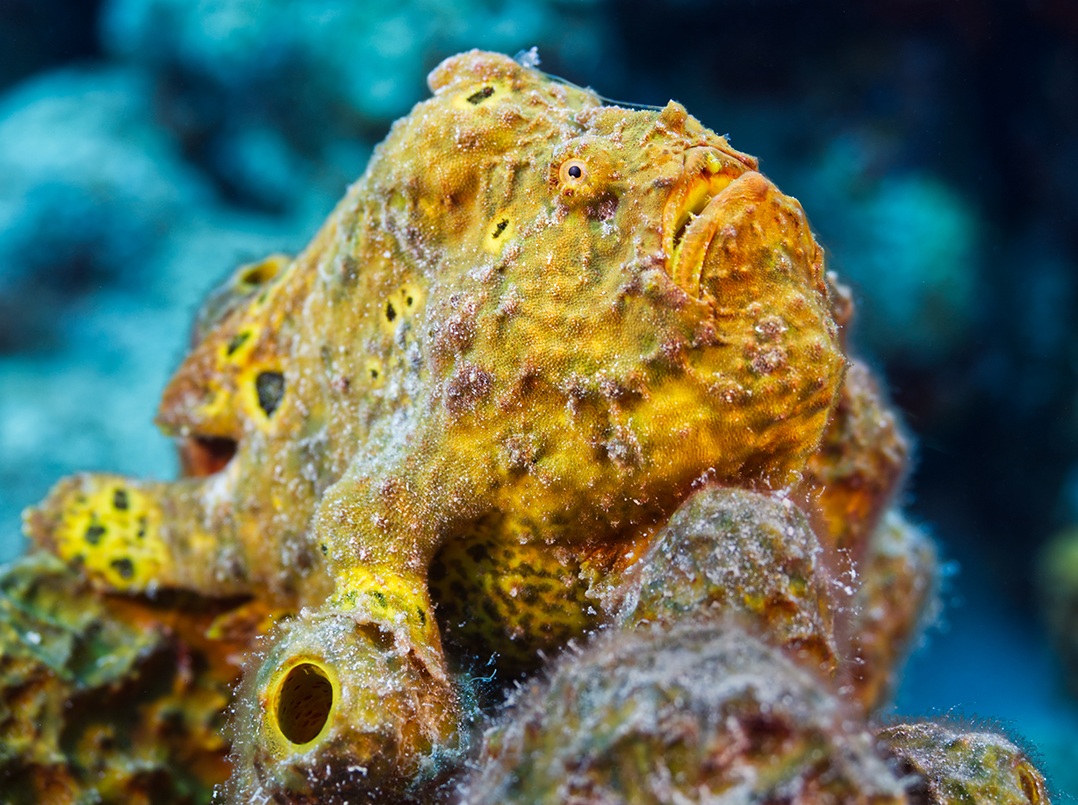
12. St. Croix, United States Virgin Islands
Peaceful St. Croix is the largest of the USVI’s three main islands. Its versatile waters blend the best of both worlds, as beginner-friendly shallow reefs meet thrilling wall dives and swim-throughs. For instance, Cane Bay Wall drops from 40 feet (12m) to over 3,000 feet (900m), with plenty to see within recreational limits, from seahorses and stingrays to 300-year-old anchors.
Continuing the theme of ‘something for everyone’, the selection of shipwrecks at Butler Bay – from tugboats to giant oil barges – caters to newer divers, seasoned divers, boat divers, and even shore divers. This is some of the best wreck diving in the Caribbean.
Finally, Frederiksted Pier is outstanding, especially after dark. Indeed, night divers regularly spot octopuses, squid, frogfish, crustaceans, and other nocturnal critters.

13. Saba
Known as the Unspoiled Queen, Saba’s wild land and seas both have protected status. The result is a canvas of lush jungle mountains and rugged coastlines that sit above an underwater haven of striking reefs and biodiversity.
Saba is particularly renowned for its dramatic topography. Diamond Rock is dotted with caves and tunnels, while Man O’ War Shoals offers an unforgettable swim-through between two high-rise pinnacles. The volcanic seascape is lined with impressive corals and creatures, such as octopuses, barracuda, frogfish, batfish, crustaceans, and eels. Lucky divers might also encounter larger life, such as turtles, hammerheads, or humpback whales.
Saba is a wishlist destination, and it certainly has some of the best diving and snorkeling in the Caribbean. However, it’s only five square miles (13 square kilometers), so it’s typically enjoyed as part of a longer trip to nearby St. Maarten.

14. Saint Lucia
Saint Lucia has volcanic origins that contribute to its underwater environment known for exciting topography! Pinnacles, walls and reefs are top-notch here, with some of the most notable including Keyhole Pinnacles, Anse Chastanet Reef and The Pinnacles. Wreck lovers are also catered to in St. Lucia with the Lesleen M wreck, a 165-foot (50m) cargo vessel home to schools of colorful reef fish, sponges and hard corals. Sea turtles and manta rays frequent the waters across Saint Lucia as well.
In terms of visibility, St. Lucia typically offers 50 to 100 feet (15 to 30 meters), providing excellent conditions for photography, too. Within St. Lucia, the Soufrière Marine Management Area (SMMA) is a protected zone that encompasses several top dive sites, ensuring the preservation of marine habitats.

15. Providencia, Colombia
Providencia, a Caribbean island in Colombia, is known for pristine reefs, colorful marine life and a relatively undisturbed marine environment. A key reason for this is conservation efforts in the region, such as Providencia’s involvement as part of the Seaflower Biosphere Reserve, a UNESCO-designated area that protects its rich marine biodiversity.
Visibility here often exceeds 100 feet (30 meters), providing exquisite conditions for underwater photography! Tropical fish are abundant in the coral gardens of Open Water Diver level-friendly sites, such as Crab Cay (Cayo Cangrejo). While dive sites, including El Pico and Southwest Bay, offer more dramatic rock formations and drop-offs into deeper waters for Advanced Open Water Divers and beyond. The best time to visit Providencia is during the dry season (December to April) to ensure rich diversity and clear waters.
FAQs About Diving in the Caribbean
Still have questions? We’ve got answers!
What is the best time of year to go diving in the Caribbean?
The Caribbean offers excellent diving year-round, but the ideal time depends on weather conditions and your preferences.
- Dry season (December to April): This period offers the most favorable conditions above and below the surface. The lower rainfall results in calmer seas and better visibility. Keep in mind that dry season is high season, so you’ll want to book dive trips further in advance.
- Wet Season (May to December): These months are also known as hurricane season, when generally wet conditions prevail. However, diving is still possible, and prices will often be lower! Marine life remains vibrant during the wet season, but visibility may be negatively impacted.
What marine life can I see in the Caribbean?
The Caribbean offers a rich and colorful underwater scene for divers! Common pelagics include barracudas, groupers and multiple shark species. While rain coral, elkhorn and soft corals thrive amongst parrotfish, angelfish and butterflyfish. For more information on the species you’ll see during the year, head to our Caribbean dive guide here.
What certification level do I need to dive in the Caribbean?
Most regions of the Caribbean are comfortable for all certification levels, whether you’re looking to learn to dive or want a challenge as a PADI Pro. Beginners are best suited to destinations with shore diving and calm conditions, like Belize, Bonaire and the Cayman Islands. While seasoned Advanced Open Water Divers and PADI Pros will appreciate the swim-throughs and caverns in St. Croix or Saba!

Have We Tempted You?
It’s safe to say the Caribbean holds a serious attraction level for both divers and non-divers. If these top Caribbean dive spots have tempted you, it may be time to book your next adventure!
Mix topside activities with underwater exploration at one of the best scuba diving resorts in the Caribbean. Or, get away from it all with the ultimate liveaboard trip. November to April is generally the best time of year to dive in the Caribbean (June to November has a risk of hurricanes in some parts), but there’s excellent diving to be had year-round.
Contact PADI Travel today to find out where the best diving in the Caribbean for your interests is – and make your dream scuba getaway a reality!
How To Experience the Best Diving in the Caribbean
Not a diver yet? Then get ready to jump in! Many of these destinations promise some of the best Caribbean diving for beginners and are also great for learning to scuba dive. There’s nothing better than the thrill of learning a skill that opens your eyes to a whole new world of unfiltered adventure and travel experiences.
Sign up for a PADI Open Water Diver course at one of the resorts linked above, or contact your local PADI Dive Shop to get started before your next vacation. Once you’ve experienced some of the best diving in the world, you’ll never regret learning to #LiveUnfiltered.







